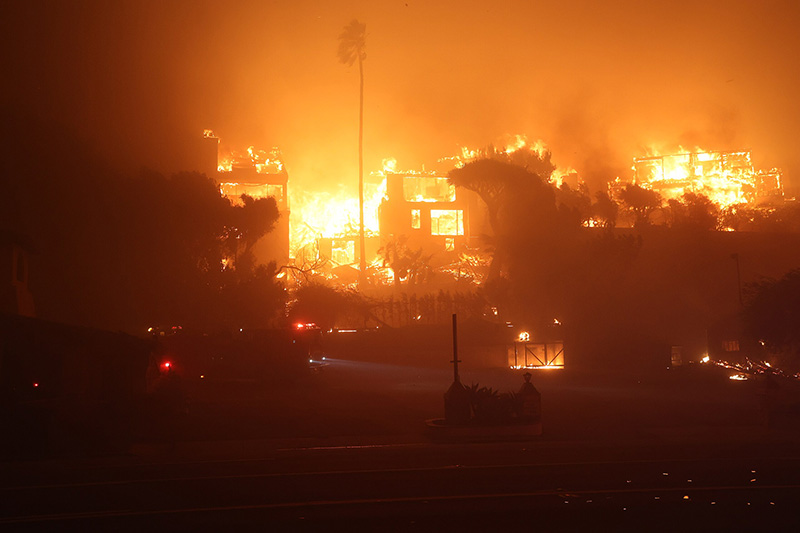UCI Experts: LA Fires and Home Hardening

Jan. 24, 2025 - Tirtha Banerjee, UCI associate professor of civil and environmental engineering, is a global expert on the turbulence of wildfires. His Boundary Layers and Turbulence Lab is one of the handful around the world studying the interplay between fire, vegetation and the atmosphere. Banerjee and UCI Chancellor’s Professor Amir AghaKouchak, a leading expert on climate extremes and their effect on the environment, offer insight into the LA fires and how homes can be protected.
Why have we seen such major fires in the Pacific Palisades and other areas of LA?
AghaKouchak: Above average temperatures combined with extremely low precipitation create the perfect conditions for wildfires. From October to December, the total rainfall was only 0.04 inches in Los Angeles. That’s the lowest since 1944 while temperatures were 1.6 degrees Farenheit above average. In the past two years, we’ve also had above average rainfall with additional vegetation growth. All that vegetation dries out and all you need is ignition. To make matters worse, extreme Santa Ana winds played a huge role. With 100 mph winds, embers can quickly spread the fire.
Banerjee: We also have multiple fires straining firefighting resources and embers traveling long distances to buildings built with wood and other vulnerable elements. It’s often embers that start a fire in a house. That’s true for most extreme wildfire events, such as the ones we've seen in California or Hawaii. The consensus is that the damage from these extreme wildland-urban interface fires are a home hardening problem.
Were you surprised that this happened?
AghaKouchak: We expect fires to happen pretty frequently. In terms of impact and destruction, this was unprecedented. We had these perfect conditions for a human disaster.
Banerjee: I wasn’t surprised, honestly, given we have seen variations of the same behavior in previous fires. What’s surprising was the extreme level of these gusts. Santa Ana gusts are usually 30-50 mph, but in this case, some were 100 mph.
Why have wildfires been getting more intense?
Banerjee: We’ve seen fires becoming more intense in the past 20 years compared to the 80 years prior. We’re having a lot more ignitions and in places we didn’t see before, and a small number of fires are burning a lot more area, making fires more extreme and erratic. More people are also living in remote areas. That leads to more sources of ignition and more wildfire risk to lives and property.
Due to long-term fire suppression, we also have more fuel buildup in a lot more areas. In Southern California, we see that in grass, shrub and brush. In the Sierras, we have tall coniferous forests. For the LA fires, the previous two years of good rain meant we had a lot more fuel now under very dry conditions and ready to burn. On top of that, the state has mountains that drive the Santa Ana winds. The mountainous terrain creates patterns of wind and turbulence that creates more extreme fires.
AghaKouchak: Looking at California, we see a significant upward trend in burnt areas because we have a lot of open spaces and natural parks with trees, forests, shrubs with very little management. Fires are happening at higher and higher elevations. Places that used to be too cold or too wet to burn now have fires happening there.
Why?
AghaKouchak: One reason could be warming temperatures. We’ve seen 1 degree Celsius of warming in the past 60 years on average and that can intensify fires. We can’t say climate change is the cause of fires, but it can intensify fires that happen.
What human practices are causing this problem?
AghaKouchak: We’ve done attribution studies that look at burnt areas with and without human emissions. Without human emissions, the number of fires and burnt areas goes down significantly. About 170% can be attributed to anthropogenic emissions.
In terms of ignition, camping, outdoor activities, parties, and fireworks can cause fires. Regarding climate change, with more greenhouse gas emissions, we expect more warming. We can’t do much about this immediately. But we’re hoping in the next decades, we’ll reduce our emissions.
What is the biggest misunderstanding about wildfires?
Banerjee: There’s almost unanimous consensus in the fire community that the building damage in the fire urban interface has a lot to do with the individual building characteristics and defensible space around it. Rather than having a big wall of flame coming to a neighborhood, most of the time the damage is caused by embers causing spot fires very close to a house or directly igniting a house.
What can we do to prevent wildfires?
AghaKouchak: We can’t prevent them from happening, but we need to minimize their impact. One is having evacuation plans like we do for hurricanes. If we can quickly evacuate people, first responders can focus on saving structures.
In California, we should come up with a more efficient process to remove dead trees and brush in urban areas as the current one is difficult and requires approval. We also need to work on our building codes to make our buildings more fire resistant. This includes building materials and coatings to reduce the flammability of our buildings.
Banerjee: We have to think about building in a more fire-resistant way such as using more fire-resistant materials, clearing flammable materials near the household, and having a defensible space. Vents can let embers get in. Patio furniture or pine needles in the gutters can be flammable too.
What can homeowners do?
Banerjee: Look at your current home and make sure you have a clear defensible space such as a 30 feet radius with no flammable materials around your home and a secondary 100 feet radius. That creates a fighting chance for firefighters to save the house.
(Answers have been condensed for clarity)
- Natalie Tso
